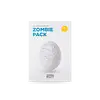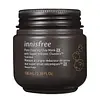What's inside
What's inside
 Key Ingredients
Key Ingredients

 Benefits
Benefits

 Concerns
Concerns

 Ingredients Side-by-side
Ingredients Side-by-side

Albumen
Skin ConditioningZea Mays Silk Extract
Skin ConditioningSilica
AbrasiveAllantoin
Skin ConditioningAloe Barbadensis Leaf Extract
EmollientPanthenol
Skin ConditioningLavandula Angustifolia Oil
MaskingPropolis Extract
Skin ConditioningParfum
MaskingBenzyl Benzoate
AntimicrobialWater
Skin ConditioningButylene Glycol
Humectant1,2-Hexanediol
Skin ConditioningNiacinamide
SmoothingCentella Asiatica Extract
CleansingRosa Centifolia Flower Extract
AstringentHippophae Rhamnoides Extract
MaskingBetula Alba Juice
AstringentAnastatica Hierochuntica Extract
AstringentAdenosine
Skin ConditioningCopper Tripeptide-1
Skin ConditioningGlycerin
HumectantSodium PCA
HumectantDisodium EDTA
Arnica Montana Flower Extract
MaskingEchinacea Angustifolia Extract
MoisturisingCommiphora Mukul Resin Extract
Skin ConditioningAlbumen, Zea Mays Silk Extract, Silica, Allantoin, Aloe Barbadensis Leaf Extract, Panthenol, Lavandula Angustifolia Oil, Propolis Extract, Parfum, Benzyl Benzoate, Water, Butylene Glycol, 1,2-Hexanediol, Niacinamide, Centella Asiatica Extract, Rosa Centifolia Flower Extract, Hippophae Rhamnoides Extract, Betula Alba Juice, Anastatica Hierochuntica Extract, Adenosine, Copper Tripeptide-1, Glycerin, Sodium PCA, Disodium EDTA, Arnica Montana Flower Extract, Echinacea Angustifolia Extract, Commiphora Mukul Resin Extract
Water
Skin ConditioningButylene Glycol
HumectantTitanium Dioxide
Cosmetic ColorantSilica
AbrasiveGlycerin
HumectantCaprylic/Capric Triglyceride
MaskingTrehalose
HumectantVolcanic Ash
AbrasiveCetearyl Alcohol
EmollientStearic Acid
CleansingGlyceryl Stearate
EmollientBentonite
AbsorbentZinc Oxide
Cosmetic ColorantPolysorbate 60
EmulsifyingCamellia Sinensis Leaf Extract
AntimicrobialCitrus Unshiu Peel Extract
MaskingOpuntia Coccinellifera Fruit Extract
Skin ConditioningOrchid Extract
Skin ConditioningCamellia Japonica Leaf Extract
Skin ConditioningCryptomeria Japonica Leaf Extract
HumectantBambusa Vulgaris Extract
Skin ConditioningTheobroma Cacao Extract
Skin ConditioningKaolin
AbrasivePolyvinyl Alcohol
Hydrogenated Vegetable Oil
EmollientPvp
Emulsion StabilisingDextrin
AbsorbentPEG-100 Stearate
Sorbitan Stearate
EmulsifyingCellulose Gum
Emulsion StabilisingXanthan Gum
EmulsifyingLactic Acid
BufferingTetrasodium Pyrophosphate
BufferingDisodium EDTA
Ethylhexylglycerin
Skin ConditioningPhenoxyethanol
PreservativeCI 77491
Cosmetic ColorantWater, Butylene Glycol, Titanium Dioxide, Silica, Glycerin, Caprylic/Capric Triglyceride, Trehalose, Volcanic Ash, Cetearyl Alcohol, Stearic Acid, Glyceryl Stearate, Bentonite, Zinc Oxide, Polysorbate 60, Camellia Sinensis Leaf Extract, Citrus Unshiu Peel Extract, Opuntia Coccinellifera Fruit Extract, Orchid Extract, Camellia Japonica Leaf Extract, Cryptomeria Japonica Leaf Extract, Bambusa Vulgaris Extract, Theobroma Cacao Extract, Kaolin, Polyvinyl Alcohol, Hydrogenated Vegetable Oil, Pvp, Dextrin, PEG-100 Stearate, Sorbitan Stearate, Cellulose Gum, Xanthan Gum, Lactic Acid, Tetrasodium Pyrophosphate, Disodium EDTA, Ethylhexylglycerin, Phenoxyethanol, CI 77491
 Reviews
Reviews

Ingredients Explained
These ingredients are found in both products.
Ingredients higher up in an ingredient list are typically present in a larger amount.
Butylene Glycol (or BG) is used within cosmetic products for a few different reasons:
Overall, Butylene Glycol is a safe and well-rounded ingredient that works well with other ingredients.
Though this ingredient works well with most skin types, some people with sensitive skin may experience a reaction such as allergic rashes, closed comedones, or itchiness.
Learn more about Butylene GlycolDisodium EDTA plays a role in making products more stable by aiding other preservatives.
It is a chelating agent, meaning it neutralizes metal ions that may be found in a product.
Disodium EDTA is a salt of edetic acid and is found to be safe in cosmetic ingredients.
Learn more about Disodium EDTAGlycerin is already naturally found in your skin. It helps moisturize and protect your skin.
A study from 2016 found glycerin to be more effective as a humectant than AHAs and hyaluronic acid.
As a humectant, it helps the skin stay hydrated by pulling moisture to your skin. The low molecular weight of glycerin allows it to pull moisture into the deeper layers of your skin.
Hydrated skin improves your skin barrier; Your skin barrier helps protect against irritants and bacteria.
Glycerin has also been found to have antimicrobial and antiviral properties. Due to these properties, glycerin is often used in wound and burn treatments.
In cosmetics, glycerin is usually derived from plants such as soybean or palm. However, it can also be sourced from animals, such as tallow or animal fat.
This ingredient is organic, colorless, odorless, and non-toxic.
Glycerin is the name for this ingredient in American English. British English uses Glycerol/Glycerine.
Learn more about GlycerinSilica, also known as silicon dioxide, is a naturally occurring mineral. It is used as a fine, spherical, and porous powder in cosmetics.
Though it has exfoliant properties, the function of silica varies depending on the product.
The unique structure of silica enhances the spreadability and adds smoothness, making it a great texture enhancer.
It is also used as an active carrier, emulsifier, and mattifier due to its ability to absorb excess oil.
In some products, tiny microneedles called spicules are made from silica or hydrolyzed sponge. When you rub them in, they lightly polish away dead skin layers and enhance the penetration of active ingredients.
Learn more about SilicaWater. It's the most common cosmetic ingredient of all. You'll usually see it at the top of ingredient lists, meaning that it makes up the largest part of the product.
So why is it so popular? Water most often acts as a solvent - this means that it helps dissolve other ingredients into the formulation.
You'll also recognize water as that liquid we all need to stay alive. If you see this, drink a glass of water. Stay hydrated!
Learn more about Water